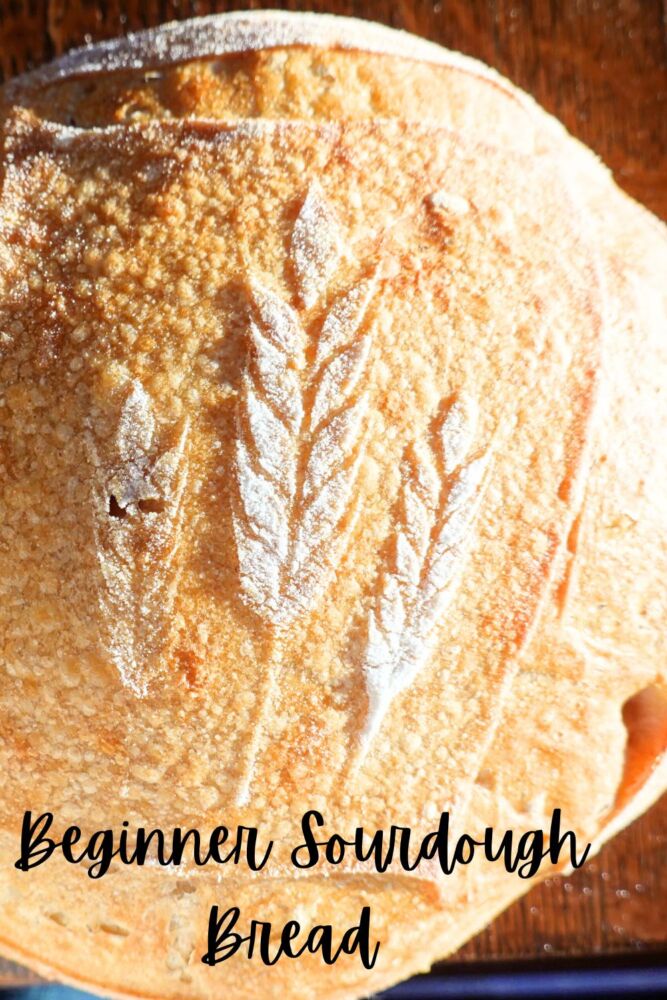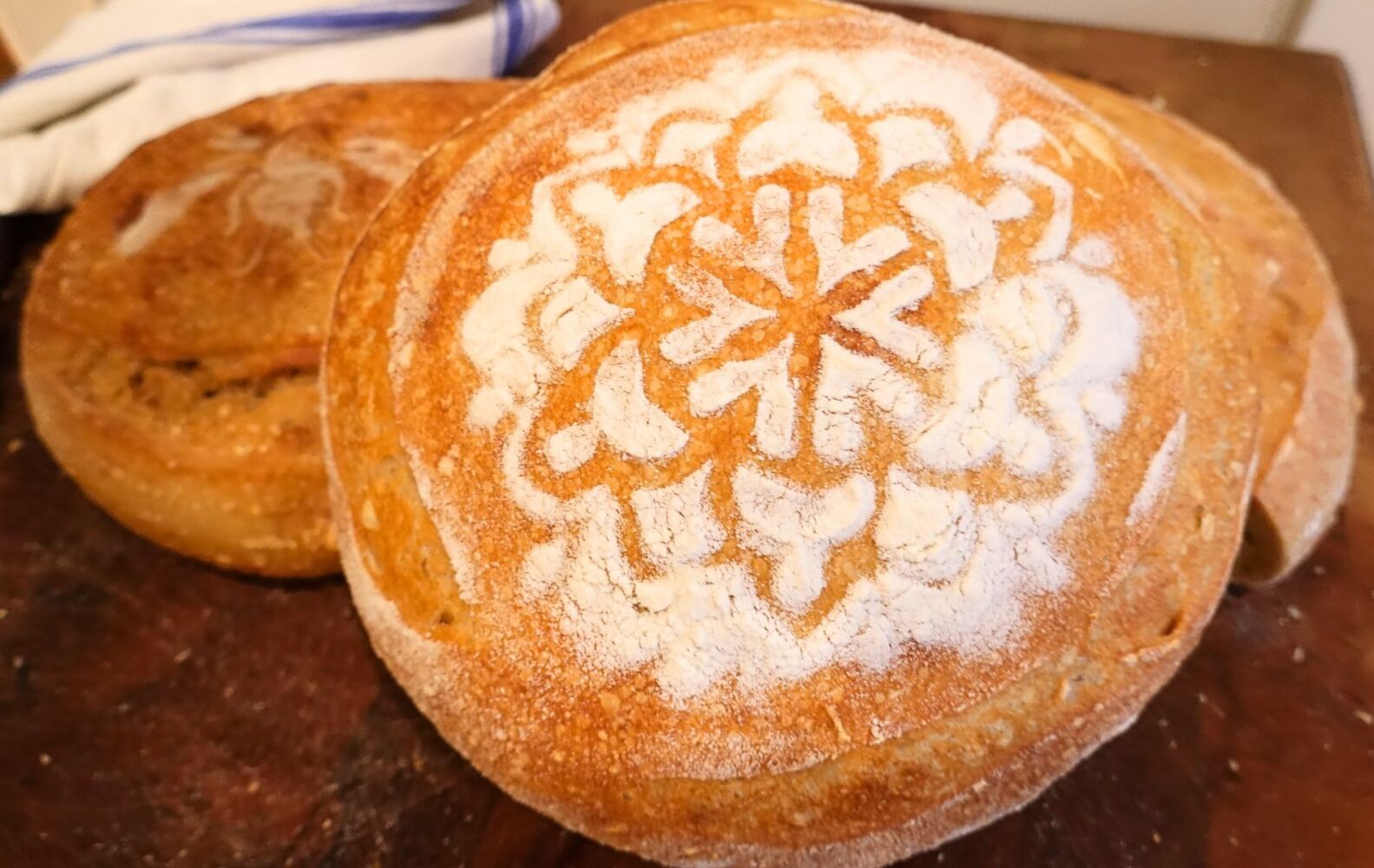This is a step-by-step tutorial for beginner’s sourdough bread recipe. An easy recipe that will give you success in baking beautiful artisan bread. Your first sourdough recipe needs to be uncomplicated so you will be encouraged to learn the art of sourdough. I use simple terms and instructions for new sourdough bakers.
Health Benefits of Sourdough Bread
- Easier to digest because the bacteria and yeast predigest flour making it easier for us to digest.
- Lactic acid bacteria/yeast predigest (carbohydrates) sugars which lessons the carbs, therefore a lower glycemic index.
- Sourdough Fermentation enhances bio-availability of vitamins and minerals by neutralizing phytic acid, an anti-nutrient.
- Lactic Acid Bacteria add aroma, flavor, and texture but also extends the shelf life of sourdough bread.
- Prebiotics survive the baking process and are great food for our gut flora.
Why Beginner’s Sourdough Bread Recipe is one of my favorite things
- Baking bread for those you love is one of the nicest things you can do for them. It is so important to make your food from scratch these days. Because you control the ingredients, nothing hidden = Better health.
- You can save an enormous amount of money by making your own bread. There are only 3 ingredients in sourdough: flour, water, and salt. The time spent baking bread is a labor of love.
- Breaking bread together with your family and friends is priceless. The Bible references bread numerous times. The smell of bread baking says to everyone in your home “I Love You and Welcome Home”.
Tools you may need
- Bowl-I like to use glass bowls with lids
- Spoon or Danish Dough Whisk
- Kitchen Scale–my favorite because so convenient but optional
- Measuring Cups and Spoons
- Banneton Basket – (Basket or Bowl will Work)
- Unbleached Parchment Paper
- Tea Towels for lining baskets
- Dutch Oven-I love the Lodge Combo-Cooker
- Lame or Razor Blade to score dough
- Bench Scraper-helpful but optional.
- Oven mitts-I use the Ove Glove
- Sourdough Kit–if you want to buy all-in-one
Visit my Amazon Storefront for my favorites tools that help baking Sourdough more convenient!
“As an Amazon Associate I may be compensated for some items linked in this post at no extra cost to you. Thank you!”
If you do not have a banneton basket or a dutch oven to bake then go to this blog post and make this super easy beginner sourdough! Actually this recipe was my first bread recipe and a family favorite.
Ingredients for Beginner’s Sourdough Bread Recipe
- Unbleached All-Purpose Flour – organic is best
- Salt-I use Redmond’s or sea salt
- Water -if you only have access to tap water then leave water out uncovered overnight so the chlorine will dissipate.
- Happy Active Sourdough Starter
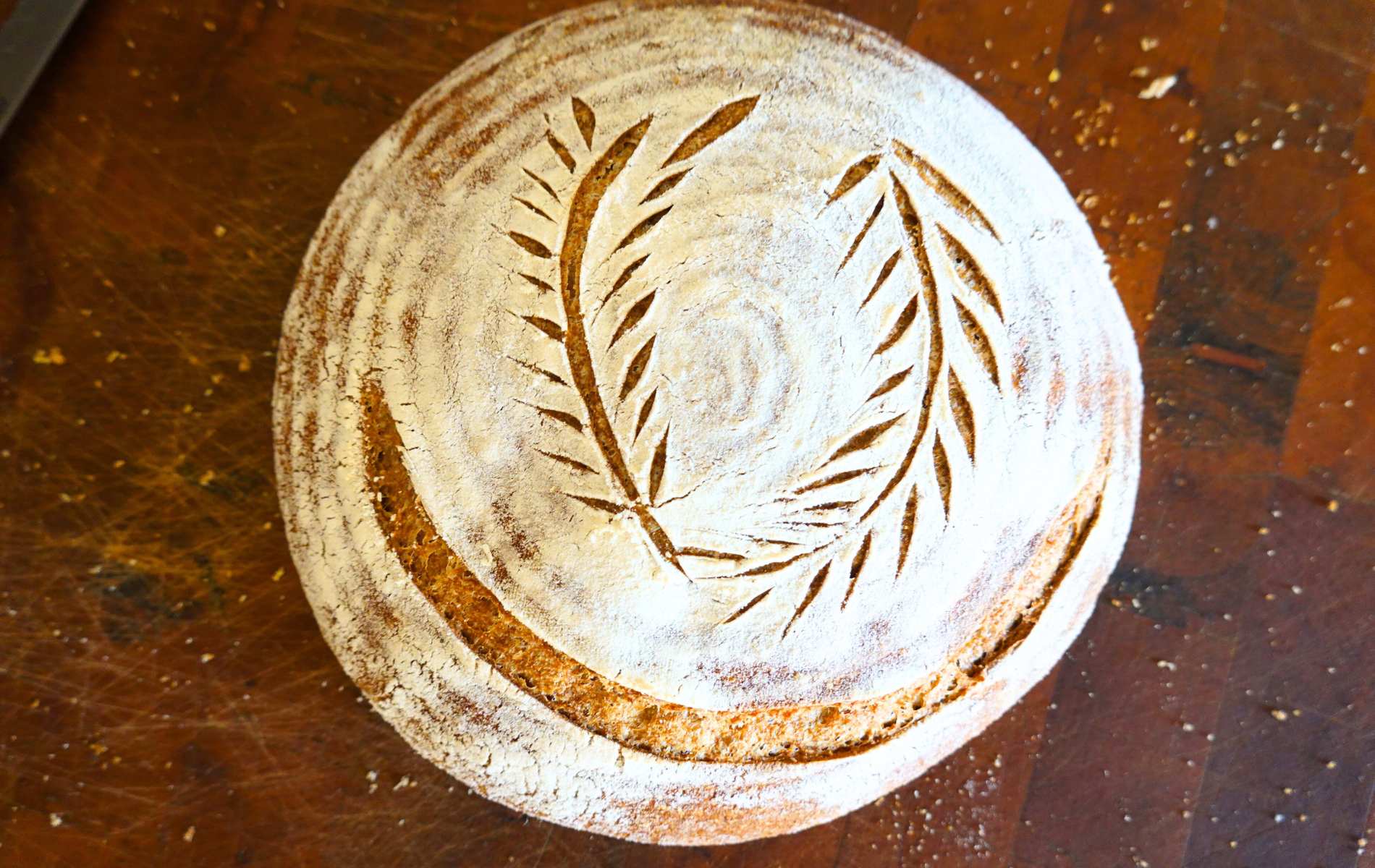 Beginner’s Sourdough Bread Recipe starts with an active starter
Beginner’s Sourdough Bread Recipe starts with an active starter
If you need help making your own sourdough starter I have a video to help you through the process step-by-step.
Signs of an active starter ready to bake bread!
- Put a teaspoon of starter in water. If the starter floats then it is ready. If it sinks then wait longer and try again.
- The float test works great but you should also look for other signs.
- Do you see the center sink and gluten strands pull away from the jar when you tap the jar on the counter?
- Did the starter double in size? You can put a rubber band on the jar so you can see this.
- Is the starter bubbly and active? it should have a dome shape on top. This means the center is higher than the edges touching the jar.
These are clues to know if your starter is strong enough to bake. The float test is my favorite and very reliable but maybe look for one more clue to be sure.
Beginner’s Sourdough Bread Recipe Step-by-Step
Step 1
Feed your sourdough starter
Feed Your Sourdough Starter 4-12 hours before you are ready to make bread.
Your starter needs to be very active and bubbly so your bread will rise.
How To Feed Sourdough Starter
- Discard all the starter in your jar except 1-4 tablespoons.
- Keep discard in a jar in the refrigerator. You will want to save every bit for discard recipes.
- You can feed your starter in a clean jar if you want.
Add to jar:
- 1/4 cup water-room temperature-if you only have access to tap water leave water out uncovered overnight so the chlorine will dissipate.
- 1/2 cup flour -I use organic unbleached all-purpose flour to feed my starter.
- 1/4 cup sourdough starter-use anywhere from 1-4 tablespoons
*This ratio is 1:1:1 (This is by weight not volume)
Mix with a spoon, cover and leave out at room temperature anywhere from 4-12 hours-depending on the ambient temperature.
If you need help or have questions about how to store your sourdough starter I have a video.
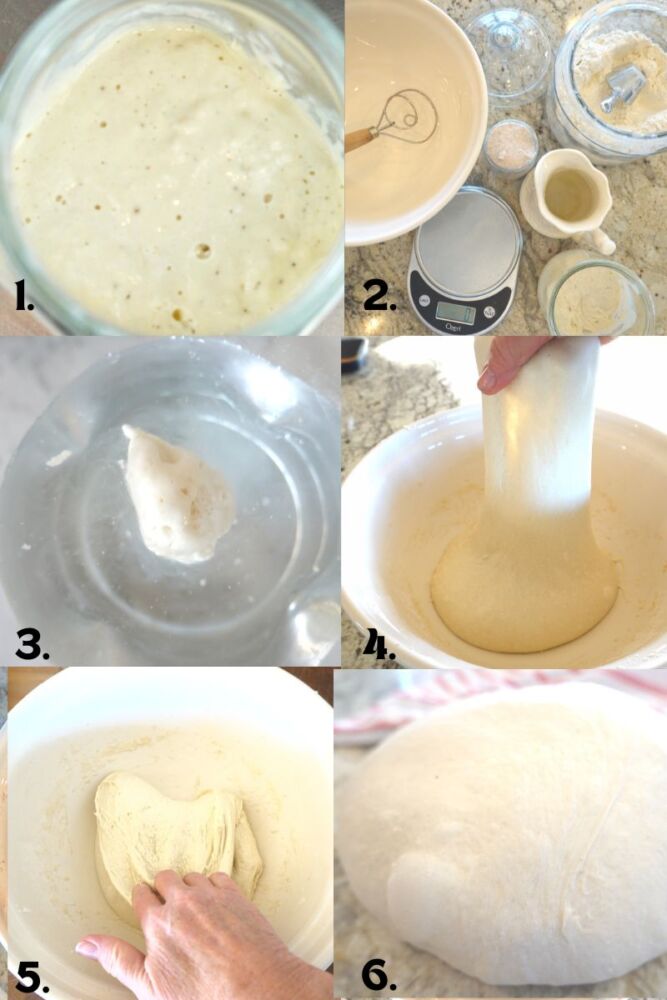
1. Active sourdough starter 2. Ingredients 3. Starter float test. 4. Stretch and Folds 5. Stretch and fold over to center 6. Shaped dough ready for banneton basket
Step 2
Mix Dough
- Feed starter 4-12 hours before you are ready to make bread.
- Place a bowl on the kitchen scale and tare to zero if weighing in grams. See equipment section for instructions to do this. Use measuring cups if you prefer. I have provided both grams and measurement amounts.
- Add 350 grams/1 1/2 cups water. Tare scale to zero.
- Add 100 grams/1/2 cup active bubbly sourdough starter. This is an easy way to do float test. The starter should float.
- Tare scale to zero.
- Add 10 grams salt/1 3/4 teaspoons – I use Redmond salt.
- Mix with a dough whisk until mixture is milky. Tare scale to zero
- Add 500 grams/ 3 1/2- 4 cups unbleached all-purpose flour
- Mix dough until all the flour is combined into a shaggy dough.
- Cover dough with a damp tea towel or put a lid on the bowl to keep the dough from drying out. Let dough rest for one hour.
What are Stretch and Folds?
Stretch and folds are a process of mixing dough that will develop gluten and strengthen dough giving your bread more rise. When you do stretch and folds the dough is in the bowl making this very convenient opposed to kneading dough on the counter. I want to add this information for those who aren’t sure if they have time to make sourdough. *It is optional to do more than one stretch and fold, you can do anywhere from 1 to 3 sets of stretch and folds 30 minutes apart. This is up to you and what you have time for. It is better to do one stretch and fold if that is all you have time for and make bread, than no bread at all! Here is what you need to know about no-knead vs. stretch and folds. Please read because this is very important information.
Step 3
Bulk Fermentation
During this stage the dough will hydrate and gluten will begin forming. The dough will be easier to manage and form into a smooth dough.
- Uncover the resting dough and do the first set of stretch and folds. Do this by pulling the dough up on the edge and stretching it up then let it fall over itself towards the center. Turn the bowl a quarter turn then stretch and fold the next side. Stretch and fold on all four sides. Just think north, east, south, west. Keep going around doing stretch and folds until the dough is smooth, maybe 2 or 3 times around on each side. This completes your first set of stretch and folds. Cover dough. If your bowl doesn’t have a lid then lay a damp tea towel on top of the dough. Go to step 4. if you only want to do one Stretch and Fold.
- Optional-Let dough rest 30 minutes then repeat the stretch and folds process. Cover dough. (This is your second set of stretch and folds).
- Optional-After the dough has rested 30 minutes it is time for the third and final set of stretch and folds.
- Leave the dough covered on the counter to bulk ferment at room temperature until you see the dough has risen by 1/3 to 1/2, and is bubbly. Take a pinch of dough and drop it in a cup of water. If it floats then it is ready to shape. If it sinks then let it bulk ferment longer. It is hard to give you an exact time due to so many variables such as ambient temperature, type of flour, and maturity of starter. My whole process from start to finish is usually about 4-6 hours in the summer and 6-8+ hours in the winter. Best to read the dough and not the clock! It is important not to over-ferment your dough. If the dough floated then it is time to shape.
Step 4
Pre-Shape
- Turn dough out onto a lightly floured counter. Turn it over itself a few times and form into a ball. Let rest for 20 minutes. During this rest the dough will form a crust or skin which will make it less sticky. The dough will be easier to final shape and won’t stick to the tea towel.
How to prepare a Banneton, basket, or bowl to bake sourdough
- Prepare your Banneton, basket or bowl, just use what you have. You can buy baskets with liners or you can use a tea towel. I like to use flour or white rice flour or a mixture (White rice flour won’t absorb moisture like flour) to lightly sprinkle over the tea towel or liner. If you don’t use a liner in the basket then you are taking a risk that the dough will stick to the basket. Not fun and will probably ruin the shape of your beautiful bread. However, if you are not using a liner I recommend using white rice flour in your Banneton to keep the dough from sticking.
Final Shape
- Lightly flour the top of the dough ball then turn it upside down.
- Gently stretch dough into a rectangle.
- Fold in each side like a burrito.
- Starting at end closest to you roll up the dough.
- Press the the ends closed on each end of the roll.
- Spin the dough ball by pushing it up and pulling it back towards you. The dough will stick to the counter (as long as you don’t use too much flour) build tension but don’t shape so tightly that the outside of the dough tears. You want a smooth, taut dough ball.
- Place a dough scraper under the dough ball and flip it top side down (smooth side of dough is down and the seam is up) in a Banneton basket or bowl lined with a floured tea towel
- Optional: After 10 minutes you can pinch the dough back together if it separates.
- Cover with a tea towel, put the basket in a 2 gallon ziplock bag or a grocery bag so the dough won’t form a hard crust.
- Let the dough rest in the refrigerator to cold-proof until the next day or 12-24 hours. The dough will slowly continue to ferment and develop flavor.
- If you want to bake the bread right away then proof at room temperature, for 1-3 hours. The amount of proof time depends on variables such as ambient temperature so these times could very! The dough should rise 1/3 to 1/2 in volume. Another method to see if your dough is properly proofed is the poke test. This is how to do a poke test. Press your finger in the dough, if it springs back very slowly and leaves a very small indent then it then it is time to prepare for baking.
Step 5
Bake
- Preheat dutch oven or cast iron combo-cooker in a 450F oven for 30 minutes.
- After 30 minutes when the oven is preheated take the dough out of the refrigerator and flip it out of the basket (Smooth side up and seam side down) on a piece of parchment paper long enough so you are able to pick up the dough and safety transfer it to the hot dutch oven.
Score or Stencil Design on Sourdough
- Flour the top of the dough.
- Score dough with a lame or razor blade. *Cold dough is easier to score. You can make deeper expansion scores or shallow artistic scores. Lots of room for creativity. Also using a stencil works well. Do expansion scores after you stencil the dough. Watch our video on how to score a sourdough pumpkin! We also have a video on how to stencil sourdough!
- Carefully place dough on parchment in the hot dutch oven then cover with the lid.
- Place in oven and set your timer for 30 minutes.
- After 30 minutes take off the lid and let the bread bake until desired color about another 10-15 minutes.Watch carefully!
- Remove bread and cool for at least a hour if you can.
Read this to learn how to score beautiful sourdough bread!
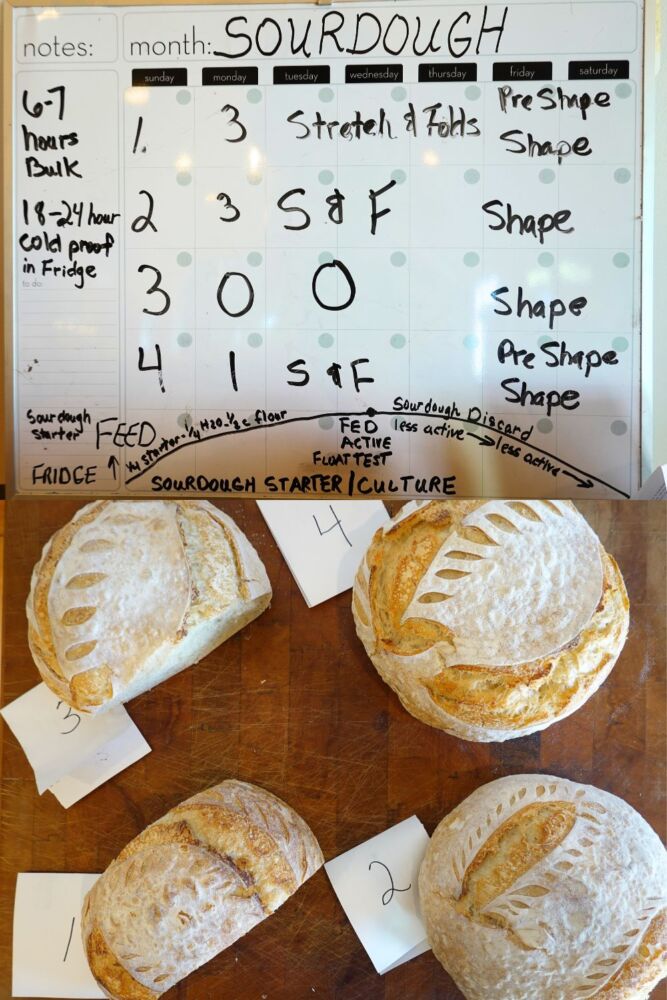
comparison of stretch and folds and shaping
Schedule example to bake Beginner’s Sourdough Bread Recipe
- 7 am. – Feed starter
- 3pm- Mix dough
- 4pm – First set of Stretch & Folds
- optional-4:30pm- Second set of Stretch & Folds
- optional-5:00pm- Third set of Stretch & Folds
- Bulk Ferment until dough passes the float test. Maybe 4+ hours or until dough passes float test
- 9pm-Pre-Shape Dough
- 9:20pm-Shape and put in proofing basket.
- Let dough cold-proof in refrigerator overnight.
- 4:30pm the next day preheat cast iron dutch oven in a 450F degree oven.
- 5pm-Bake Bread
- 5:45pm-Bread is baked.
This recipe yields about a 2 pound loaf
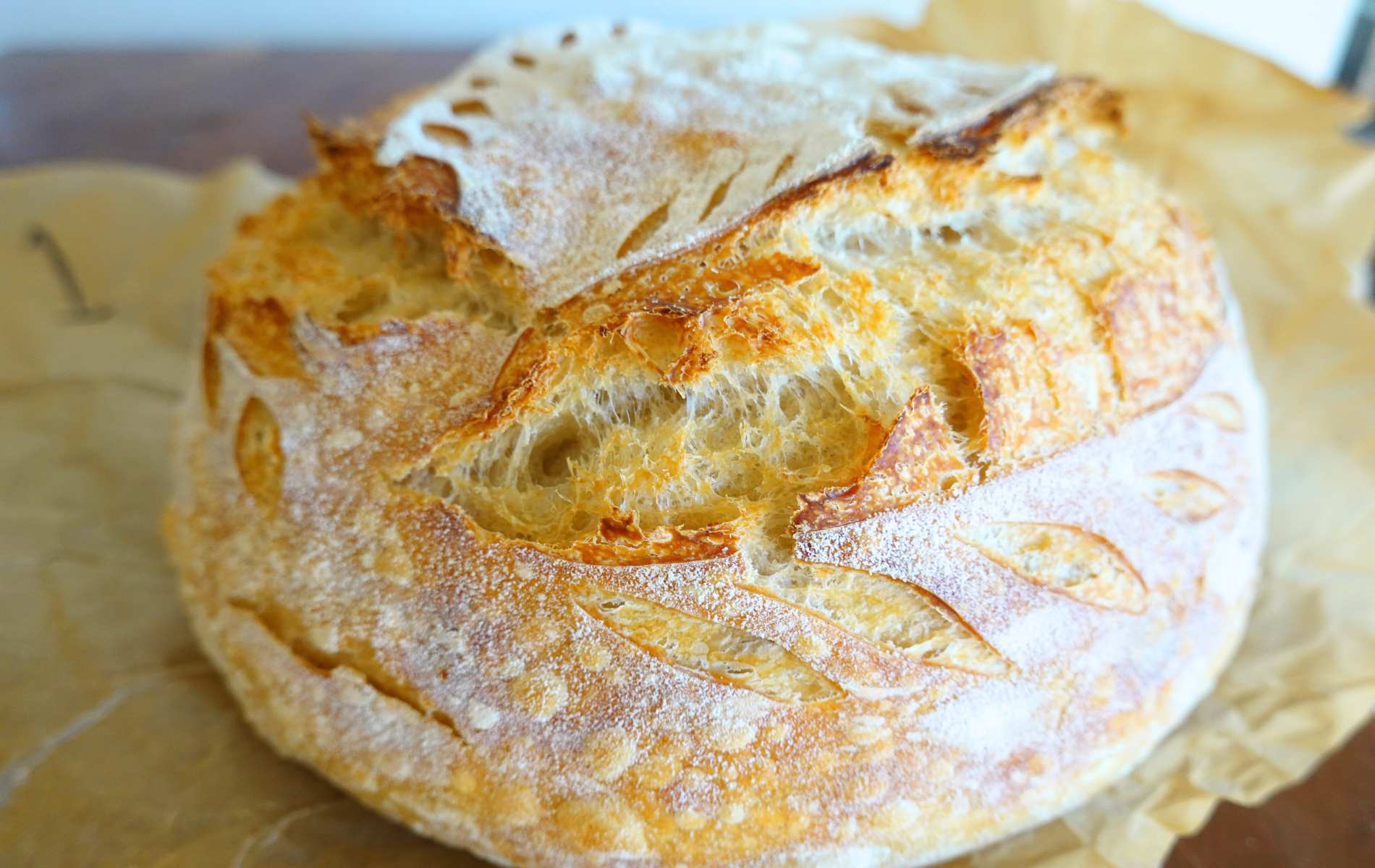 Sourdough Recipes You Will Love!
Sourdough Recipes You Will Love!
- Sourdough Chocolate Bread
- Sourdough Everything Crackers
- Sourdough Hamburger Buns (no eggs)
- Sourdough Biscuits No Baking Powder
- Sourdough Pizza Dough
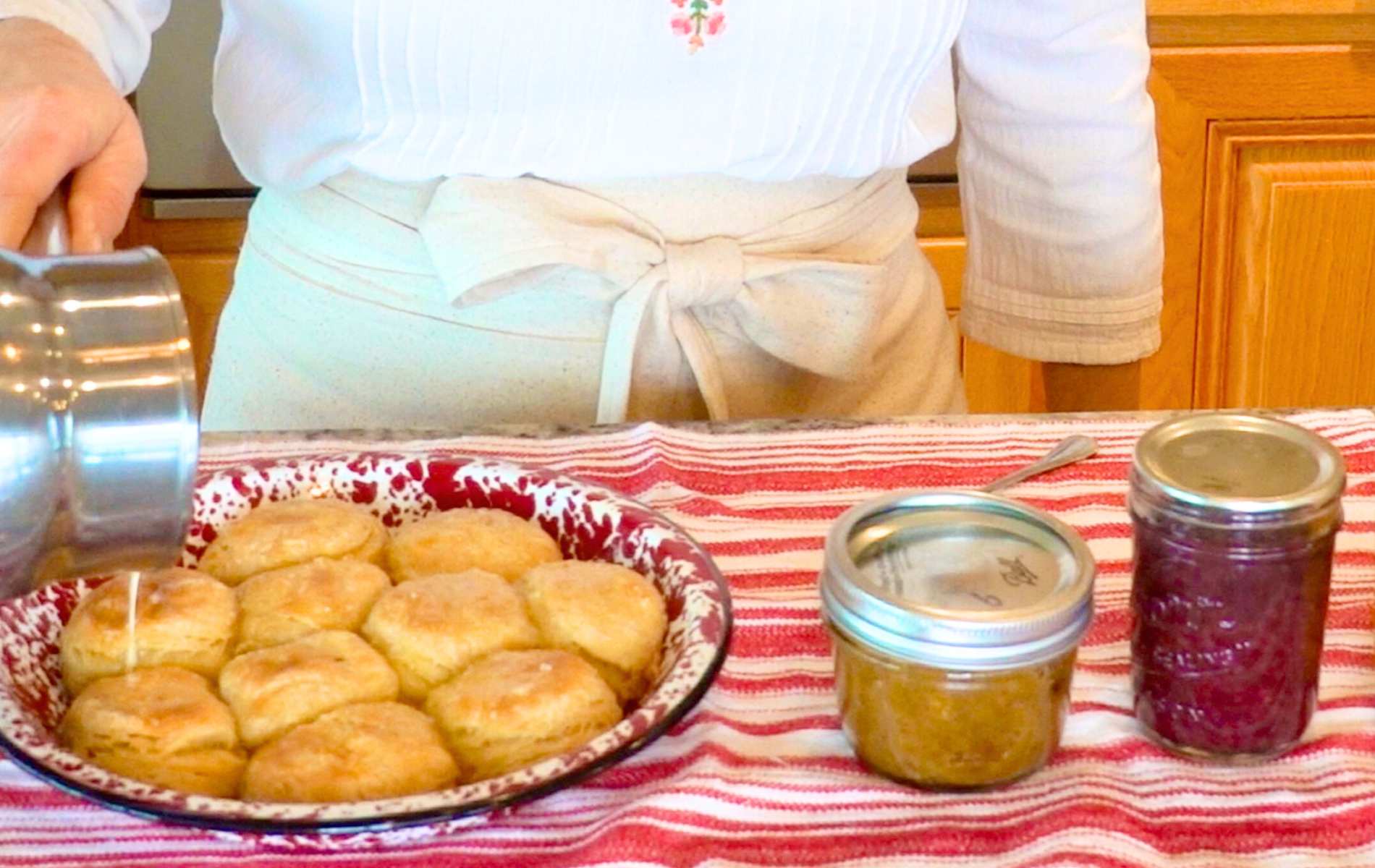
Beginner's Sourdough Bread Recipe
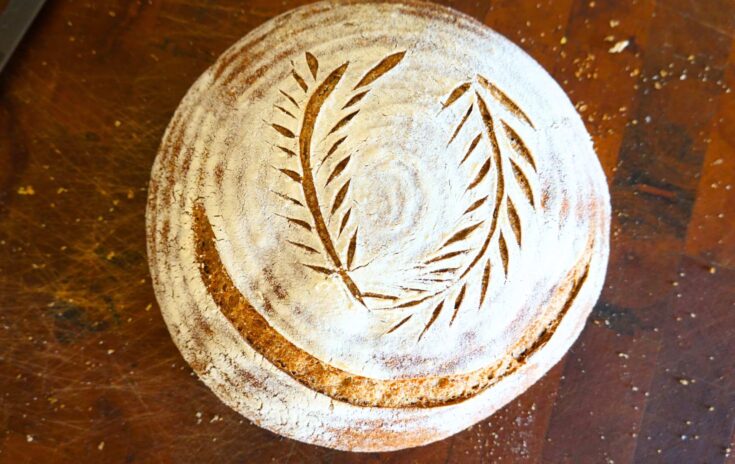
This is a step-by-step tutorial for beginner's sourdough bread recipe. An easy recipe that will give you success in baking beautiful artisan bread. Your first sourdough recipe needs to be uncomplicated so you will be encouraged to learn the art of sourdough. Learn simple terms and instructions for new sourdough bakers.
Ingredients
- 3 1/2 - 4 cups or 500 grams -Unbleached All-Purpose Flour - organic is best
- 1 3/4 teaspoons or 10 grams Salt-I use Redmond’s or sea salt
- 1 1/2 cups or 350 grams Water -if you only have access to tap water then leave water out uncovered overnight so the chlorine will dissipate.
- 1/2 cup or 100 grams Happy Active Sourdough Starter
Instructions
- Feed starter 4-12 hours before you are ready to make bread.
- Place a bowl on the kitchen scale and tare to zero if you are weighing in grams. See equipment section for instructions to do this. Use measuring cups if you prefer. I have provided both grams and measurement amounts.
- Add 350 grams (1 1/2 cups)water to the bowl. Tare scale to zero.
- Add 100 grams (1/2 cup) active bubbly sourdough starter. This is an easy way to do a float test. The starter should float.
- Tare scale to zero.
- Add 10 grams of salt (1 3/4 teaspoon) - I use Redmond salt.
- Mix with a dough whisk until mixture is milky. Tare scale to zero
- Add 500 grams (3 1/2 - 4 cups) of unbleached all-purpose flour
- Mix dough until all the flour is combined into a shaggy dough.
- Cover dough with a damp tea towel or put a lid on the bowl to keep the dough from drying out. Let dough rest for 1 hour.
- Uncover the resting dough and do the first set of stretch and folds. Do this by pulling the dough up on the edge and stretching it up then let it fall over itself towards the center. Turn the bowl a quarter turn then stretch and fold the next side. Stretch and fold on all four sides. Just think north, east, south, west. Keep going around doing stretch and folds until the dough is smooth, maybe 2-4 times around on each side. This completes your first set of stretch and folds. Cover dough. If your bowl doesn’t have a lid then lay a damp tea towel on top of the dough..
- Let dough rest 30 minutes then repeat stretch and folds process. Cover dough. This is your second set of stretch and folds.
- After the dough has rested 30 minutes it is time for the third and final set of stretch and folds.
- Leave dough covered on the counter to bulk ferment at room temperature until you see the dough has risen by 1/3 to 1/2, and is bubbly. Take a pinch of dough and drop it in a cup of water. If it floats then it is ready to shape. If it sinks then let it bulk ferment longer. It is hard to give you an exact time due to so many variables such as ambient temperature, type of flour, and maturity of starter. My whole process from start to finish is usually about 4-6 hours in the summer and 6-8+ hours in the winter. Best to read the dough and not the clock! It is important not to over-ferment your dough. If the dough floats then it is time to shape.
- Lightly flour the top of the dough ball then turn it upside down.
- Gently stretch dough into a rectangle.
- Fold in each side like a burrito.
- Starting at end closest to you roll up the dough.
- Press the the ends closed on each end of the roll.
- Spin the dough ball by pushing it up and pulling it back towards you. The dough will stick to the counter (as long as you don't use too much flour) building tension but don’t shape so tight that the outside of the dough tears. You want a smooth, taut dough ball.
- Place a dough scraper under the dough ball and flip it top side down (smooth side of dough is down and the seam is up) in a Banneton basket or bowl lined with a floured tea towel
- Optional: After 10 minutes you can "Envelope" the dough back together if it separates.
- Cover with a tea towel, put the basket in a 2 gallon ziplock bag or a grocery bag so the dough won’t form a hard crust.
- Let the dough rest in the refrigerator to cold-proof until the next day or 12-24 hours. The dough will slowly continue to ferment and develop flavor.
- If you want to bake the bread right away then proof at room temperature, for 1-3 hours. The amount of proof time depends on variables such as ambient temperature so these times could very! The dough should rise 1/3 to 1/2 in volume. Another method to see if your dough is properly proofed is the poke test. This is how to do a poke test. Press your finger in the dough, if it springs back very slowly and leaves a very small indent then it then it is time to prepare the dough for baking.
Bulk Ferment:
Pre-Shape:
Turn dough out onto a lightly floured counter. Turn it over itself a few times and form into a ball. Let rest for 20 minutes. During this rest the dough will form a crust or skin which will make it less sticky. The dough will be easier to final shape and won't stick to the tea towel.
Shape:
Bake:
- Preheat a dutch oven or cast iron combo-cooker in a 450F oven for 30 minutes.
- After 30 minutes when the oven is preheated take the dough out of the refrigerator and flip it out of the basket (Smooth side up and seam side down) on a piece of parchment paper long enough so you are able to pick up the dough and safety transfer it to the hot dutch oven.
- Flour the top of the dough.
- Score dough with a lame or razor blade. You can make deeper expansion scores or shallow artistic scores. Lots of room for creativity. Also using a stencil works well. Do expansion scores after you stencil the dough. *Cold Dough is easy to score.
- Carefully place dough on parchment in the hot dutch oven then cover with the lid.
- Place in oven and set your timer for 30 minutes.
- After 30 minutes take off the lid and let the bread bake until desired color about another 10-15 minutes.Watch carefully!
Remove bread and cool for at least a hour if you can.


